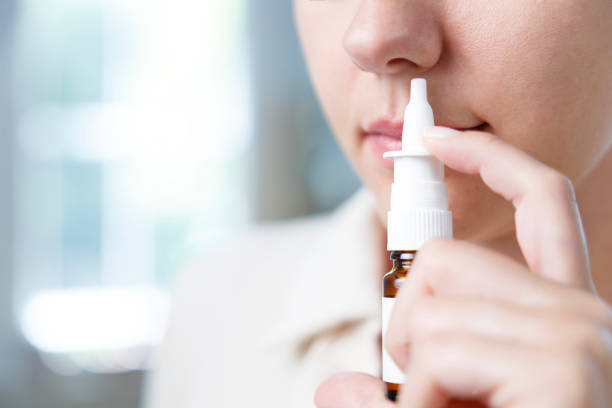USP Nasal Spray Preservative Efficacy Testing
The USP Nasal Spray Preservative Efficacy Testing is a critical quality control process designed to ensure that nasal sprays adhere to the United States Pharmacopeia (USP) standards for preservatives. This testing ensures that the products are safe, effective, and stable over time. The preservatives used in nasal sprays play a crucial role in preventing microbial contamination and ensuring product stability.
The USP guidelines specify that preservative efficacy must be demonstrated to ensure that the preservative system is capable of controlling microbiological growth under conditions that simulate actual use. This test evaluates whether the preservative is effective at inhibiting the growth of microorganisms, thereby safeguarding the integrity and safety of the nasal spray product.
The testing involves exposing the nasal spray to various microbial challenges, including fungi, bacteria, and viruses, which are representative of potential contaminants that could affect the product. The specimens are then incubated under controlled conditions to observe any changes or signs of microbial growth over time. If no significant growth is observed, it indicates that the preservative is performing as expected.
This test is essential for pharmaceutical manufacturers who wish to comply with USP standards and ensure their products meet regulatory requirements. By conducting this test, companies can demonstrate compliance with relevant sections of the USP, such as USP 615, which outlines specific procedures and criteria for nasal sprays.
The results of this testing are critical in ensuring that the product is safe for use by consumers. It helps to protect against potential health risks associated with microbial contamination, such as infections or allergic reactions. This testing also ensures that the preservative system is robust enough to maintain the product's stability and effectiveness over its shelf life.
Moreover, this test aligns with broader quality assurance practices in pharmaceutical manufacturing. By ensuring that nasal sprays meet USP standards for preservative efficacy, companies can enhance their reputation as reliable manufacturers of high-quality products. This not only benefits the company but also fosters trust among consumers and healthcare professionals.
Scope and Methodology
| Parameter | Description |
|---|---|
| Microbial Challenges | The testing involves exposing the nasal spray to various microbial challenges, including fungi, bacteria, and viruses. |
| Incubation Conditions | Specimens are incubated under controlled conditions to observe any changes or signs of microbial growth over time. |
| Data Collection | Data is collected on the rate and extent of microbial growth, if any. |
| Evaluation Criteria | The specimens are evaluated against predefined criteria to determine preservative efficacy. |
| Instrumentation | Description |
|---|---|
| Microbial Challenge Agents | Specific strains of fungi, bacteria, and viruses are used as challenge agents for the testing. |
| Incubators | Controlled temperature and humidity incubators are used to simulate real-world storage conditions. |
| Microscopy | Microscopic examination is conducted to observe any changes in microbial growth patterns.|
| Data Analysis Software | Software tools are used for data analysis, ensuring accurate and reliable results. |
Why Choose This Test
The USP Nasal Spray Preservative Efficacy Testing is an essential component of quality assurance in pharmaceutical manufacturing. By choosing this test, companies can ensure that their nasal sprays meet the highest standards of safety and efficacy.
This testing process provides several benefits to manufacturers:
- Regulatory Compliance: Ensures compliance with USP standards, which is crucial for regulatory approval.
- Risk Reduction: Reduces the risk of microbial contamination, thereby protecting public health.
- Informed Decision-Making: Provides valuable data that can inform product development and quality assurance processes.
- Consumer Trust: Enhances consumer trust by ensuring high-quality products.
The results of this testing are critical in ensuring that the preservative system is robust enough to maintain the product's stability and effectiveness over its shelf life. This not only benefits the company but also fosters trust among consumers and healthcare professionals.
By choosing this test, companies can ensure that their nasal sprays meet the highest standards of safety and efficacy, thereby protecting public health and enhancing consumer trust.
Customer Impact and Satisfaction
The USP Nasal Spray Preservative Efficacy Testing has a significant impact on customer satisfaction. By ensuring that nasal sprays meet the highest standards of safety and efficacy, this testing process enhances consumer trust in pharmaceutical products.
Customers benefit from:
- Better Health Outcomes: Reduced risk of microbial contamination leading to infections or allergic reactions.
- Increased Product Reliability: Ensured stability and effectiveness over the product's shelf life.
- Enhanced Brand Reputation: By complying with USP standards, companies can enhance their reputation as reliable manufacturers of high-quality products.
In addition to these benefits, this testing process also helps healthcare professionals prescribe safe and effective nasal sprays with confidence. This, in turn, contributes to better health outcomes for patients.
Overall, the USP Nasal Spray Preservative Efficacy Testing is a crucial step in ensuring that pharmaceutical products meet the highest standards of safety and efficacy. By choosing this test, companies can enhance customer satisfaction and trust, ultimately leading to greater success in the marketplace.





